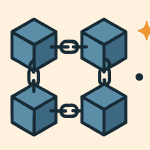If you’re learning about blockchain and cryptocurrency, you may have seen the term “consensus mechanism.” It sounds complex, but it’s actually a simple idea.
In this beginner-friendly guide, we’ll explain what a consensus mechanism is, why it matters, and the two most popular types: Proof of Work (PoW) and Proof of Stake (PoS).
Contents
What Is a Consensus Mechanism?
A consensus mechanism is the method a blockchain uses to agree on what’s true.
In a blockchain, there’s no single company or server in charge. Instead, there are many computers (called nodes) working together. A consensus mechanism helps all these nodes agree on which transactions are valid and what should be added to the blockchain.
This process keeps the system:
-
Secure
-
Decentralized
-
Trustless (no need to trust any single person or company)
Why Is Consensus Important?
Without consensus, people could cheat the system—like sending the same crypto twice or changing the transaction history.
A good consensus mechanism makes sure:
-
Only valid transactions are added
-
The blockchain is honest and unchangeable
-
Everyone sees the same version of the data
The Two Most Common Consensus Mechanisms
There are many types of consensus mechanisms, but the two most popular ones are:
-
Proof of Work (PoW)
-
Proof of Stake (PoS)
Let’s break each one down.
1. Proof of Work (PoW)
Proof of Work was the first consensus method. It’s used by Bitcoin and was originally used by Ethereum (before it switched to PoS).
In PoW, computers called miners compete to solve a complex math problem. The first one to solve it gets to add a new block to the blockchain and earn a reward (like BTC).
✅ Pros:
-
Very secure and proven over time
-
Truly decentralized
❌ Cons:
-
Uses a lot of electricity (not eco-friendly)
-
Slower and more expensive than PoS
2. Proof of Stake (PoS)
Proof of Stake is a newer method and is used by many modern blockchains like Ethereum 2.0, Cardano, Solana, and Polkadot.
In PoS, there are no miners. Instead, people lock up some of their crypto (this is called staking) to help run the network.
The system randomly selects a validator to create the next block. The more you stake, the higher your chance of being chosen.
✅ Pros:
-
Much faster than PoW
-
Uses very little energy
-
Cheaper transaction fees
❌ Cons:
-
Can be more complex to understand
-
Some argue it’s less decentralized if a few people hold most of the stake
Quick Comparison Table
| Feature | Proof of Work (PoW) | Proof of Stake (PoS) |
|---|---|---|
| Used by | Bitcoin | Ethereum 2.0, Cardano |
| Energy use | High (mining needed) | Low (eco-friendly) |
| Speed | Slower | Faster |
| Validators | Miners solve puzzles | Stakers are randomly picked |
| Cost | High fees possible | Lower transaction costs |
| Security | Very secure | Also secure with good design |
Which One Is Better?
There’s no “best” choice. Both PoW and PoS have their strengths:
-
PoW is great for maximum security. That’s why Bitcoin still uses it.
-
PoS is better for speed, energy saving, and scaling. That’s why many new blockchains use it.
More blockchains today are choosing PoS to save energy and support more users.
Final Thoughts
A consensus mechanism is how a blockchain stays honest and secure without needing a central authority. It’s the system that keeps all the parts of the network working together.
-
PoW uses computing power and is very secure but energy-intensive.
-
PoS uses staking and is faster, cheaper, and eco-friendly.
Now that you know how consensus works, you have a better understanding of how cryptocurrencies stay safe and reliable.




